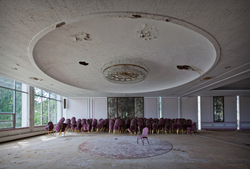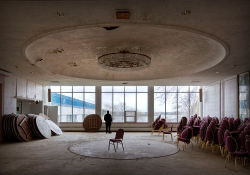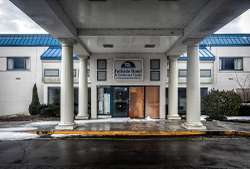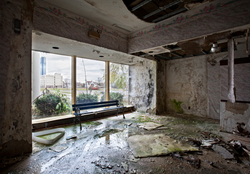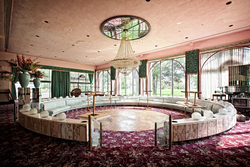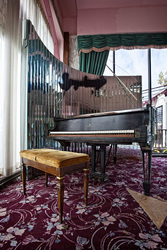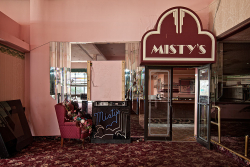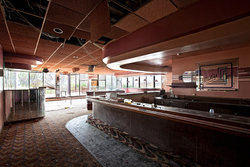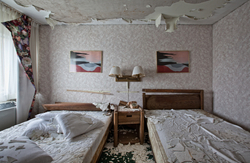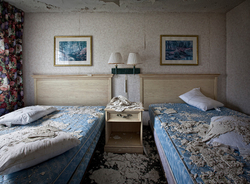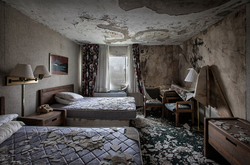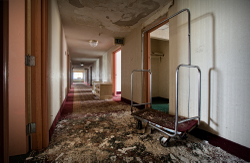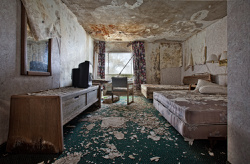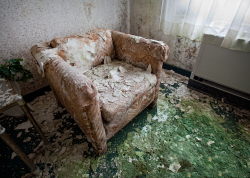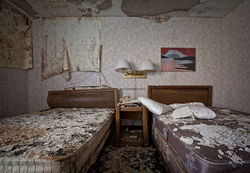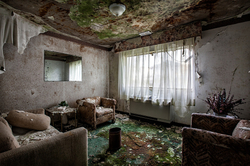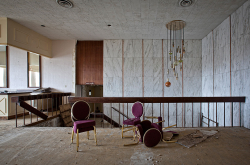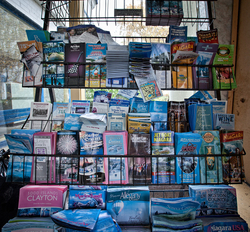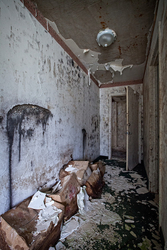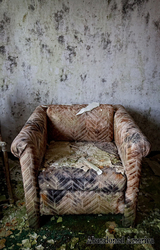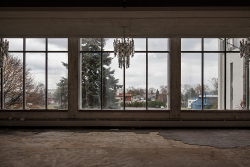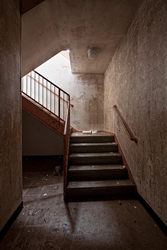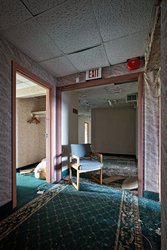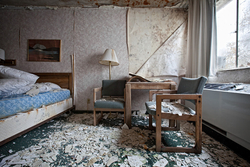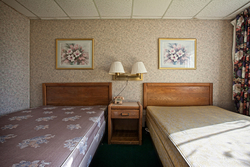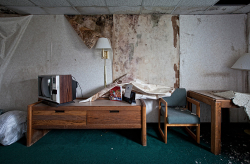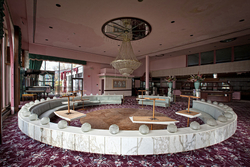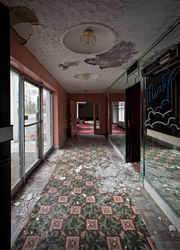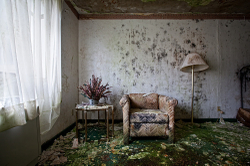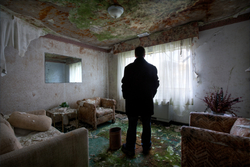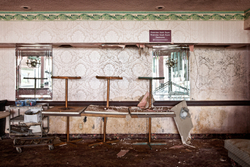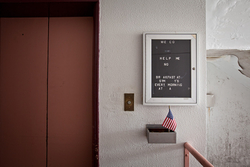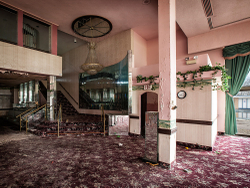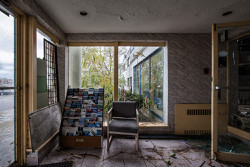Fallside Hotel and Conference Center
Updated April 17, 2023 | By Matthew Christopher
There is a certain stillness in places everyone has left, a clarity in the light that is difficult to capture in words or images. In the Fallside Hotel and Conference Center, you could feel how the building was on the cusp of something, as though it was in between worlds. Rain fogged the glass doors and poured through holes in the ceiling onto tables and nightstands. Outside the windows on the rear of the hotel, you could see the Niagara River flowing interminably along towards the falls ahead. It felt like the building was holding its breath in anticipation of something that was about to come, but nobody quite knew what it was.
A look inside one of the guest rooms of the abandoned Fallside Hotel
The Fallside had many names over the years and was operated by many different owners. Originally it was built as a Treadway Inn in 1957 on a 3.8 acre parcel of land in Niagara Falls, New York that had previously been the front lawn for the spectacular Shredded Wheat Factory. Shredded Wheat had moved their primary base of operations to Naperville, Illinois three years prior and shut down their bright, flag-festooned factory that had come to be known as the “Palace of Light”. Treadway Inn would provide the Niagara Frontier not only a haven for travelers but, as an advertisement announcing its opening proclaimed, “a place for area residents to dine, gather in meetings, entertain guests, discuss business, and convene socially.” All of the rooms had individually controlled air conditioning, “the most comfortable and modern furniture,” and their own televisions – luxuries at the time. Rates ranged from $8.35 for single rooms to $36 for three room suites. The price for breakfast was as low as 60¢ and dinner ranged from $1.75 to $5.25 in the Publick Room, which overlooked the falls. Menu items included Frog Legs Chablis, Baked Indian Pudding, Rock Cornish Game Hen, and Lobster Pie.
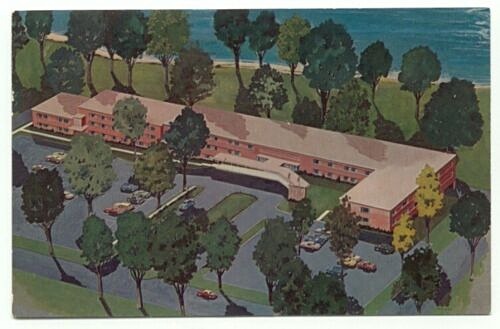
A vintage postcard shows a view of the Treadway Inn prior to the construction of the addition with the ballroom.
The Treadway Inn was in many ways symbolic of the resurgence of tourism’s prominence in the city’s economy. While Niagara Falls had attracted European visitors as early as the 1600s and had been popularized as a honeymoon destination in the early 1800s, heavy industry had been a fierce competitor for the dominant source of income since the 1800s as well. The falls were a cheap and plentiful source of power, and were also used to evacuate waste created by mills and tanneries and the untreated sewage produced by the city’s visitors and residents. The grand cataract was also home to the world’s first hydroelectric plant, built by Westinghouse in 1895 and powered by Tesla’s Polyphase Alternating Current Electricity, which was hailed by the President of the American Institute of Electrical Engineers as “the most tremendous event in all engineering history,” and the point of origin for the electrification for the world. The cheap electrical power attracted even more industries, including paper mills and petrochemical and plastics companies. Many took advantage of lax enforcement of environmental policies, dumping toxic waste including mercury, dioxins, DDTs, and PCBs in lagoons, open pits at the outskirts of town over which neighborhoods like Love Canal were built, and the river itself.
By the time the Treadway Inn was built, the environmental impact was catching up to Niagara Falls. Fish stocks dwindled, oil slicks bloomed on the surface of the waters, and dead birds were often found on the river’s banks. The toll that industry was taking on the area was becoming noticeable and as it grew would increasingly impact tourism, but through the 1960s the aging companies that created it were relocating to less expensive areas. The Schoellkopf Power Station was mostly destroyed when it collapsed into the river in 1956 and land was seized from the Tuscarora Indian Reservation to build the Robert Moses Niagara Power Plant as a replacement. The population of the area blossomed with an influx of construction workers and peaked at over 100,000 in the 1960s; fifty years later it would be under 50,000.
The Circle restaurant was the place to be seen at the Fallside Hotel during its heyday.
The Treadway Inn heralded a reinvestment in tourism, and was of such prominence in the community that when Senator John F. Kennedy visited the area during his presidential campaign in 1960, he delivered his speech in front of the inn. Three years later a new, substantially larger Treadway Inn was built four miles away and the old one became the Parkway Inn.
By the middle of the 1960s, the Parkway had over 200 guest rooms, a restaurant, a cocktail lounge, dining rooms and public rooms, administrative offices, and the Gaslight Terrace, “created to provide a turn-of-the-century atmosphere as an appropriate setting for the enjoyment of dining reminiscent of that period.” The Circle, an opulent dining area built in a recessed area of the floor, was added, and was “the place to see and be seen” according to Ralph Aversa, who worked as a night auditor balancing receipts for $1.50 an hour at the Parkway Inn from 1968-1970 and later served as a city councilman. Aversa noted that local radio station WHLD was located in the building, and that the Hal Palumbo Orchestra performed at the restaurant frequently. “The heyday of the Parkway was the 50s through the 80s,” he recalled. “Every major political figure who visited the area went through there.” Raul Sartini, an Italian immigrant who served as the General Manager at the Parkway in the early 1970s, held high standards for the establishment; Aversa fondly remembered the way Sartini would frequently check the glasses and silverware to make sure they were spotless. “If I learned anything from him,” Aversa mused, “it was to pay attention to details.”
Save for an armed holdup at the Parkway in 1965, there was an overall sense of optimism for the future of the inn and the town of Niagara Falls itself. The mayor, E. Dent Lackey, was a fervent believer in urban renewal, and aggressively pushed for the demolition of much of the historic downtown in order to secure state and federal funding to rebuild. It was to be a renaissance for the area, but ultimately hastened its decline with a number of ill-fated projects that only served to make the area less desirable to tourists. One of the most notable was the construction of the Robert Moses State Parkway, which severed access from the town to the waterfront. Though the Parkway Inn had its own exit, visitors still had to contend with crossing a highway that even Mayor Lackey described as “nothing more than a Chinese Wall” separating Niagara Falls tourists from the very destination they’d come to the town to see. With no State Historic Preservation Board to oppose it at the time, several magnificent buildings like the Strand and Cataract Theatres were razed. “Canada kept what they had and built around it, and we didn’t,” Aversa observed. “They realized earlier than we did the value of their historic downtown. We demolished and they rebuilt.”
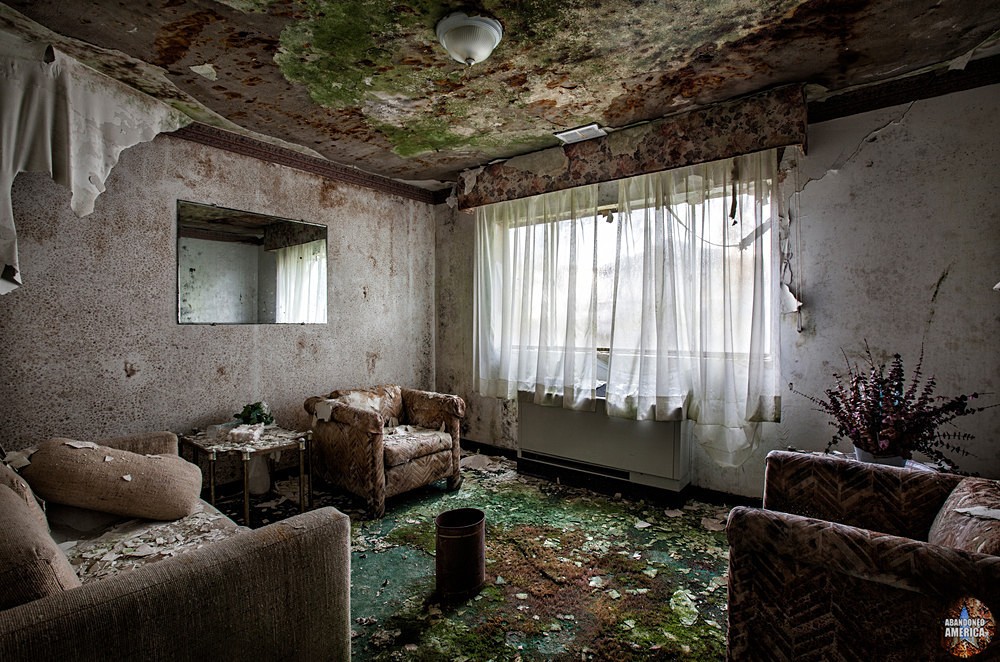
A ladies' lounge by the bathrooms at the Fallside Hotel; every surface is covered with moss, mold, or both.
By the 1970s, shells of abandoned factories dotted the town and the repercussions of the lack of environmental regulations were becoming glaringly apparent. Projects began to shuffle around toxic waste to mitigate their impact on the Niagara River and surrounding communities, but the damage had been done. In the EPA Journal, Eckardt C. Beck described the horrifying condition of the Love Canal neighborhood in 1978: “Corroding waste-disposal drums could be seen breaking up through the grounds of backyards. Trees and gardens were turning black and dying. One entire swimming pool had been had been popped up from its foundation, afloat now on a small sea of chemicals. Puddles of noxious substances were pointed out to me by the residents. Some of these puddles were in their yards, some were in their basements, others yet were on the school grounds. Everywhere the air had a faint, choking smell. Children returned from play with burns on their hands and faces.”
People were leaving Niagara Falls, New York by the thousands, and the city’s reputation was suffering. Home prices and household income would continue to plummet in the decades to come as more of Niagara Falls’ residents slipped below poverty level. In the early 1970s the Parkway Inn became a Ramada Inn, and then a few years later was rebranded yet again as the Days Inn Riverview. While the hotel boasted a Nintendo Entertainment System in every room, an outdoor heated pool, and close proximity to the casinos that were the current hope for saving the area’s economy, the facilities were becoming outdated. By the time it was rebranded yet again in 2005 by Niagara Hospitalities as the Fallside Hotel and Conference Center – with a logo design that didn’t even bother to change the overall shape from the Days Inn, presumably to cut the costs incurred by buying new signs – the hotel was worn and badly in need of repair. In what seemed to me a subtle apology for previous failings, the sign over the door breathlessly exclaimed, “Under New Ownership Major Franchise Coming Soon!”
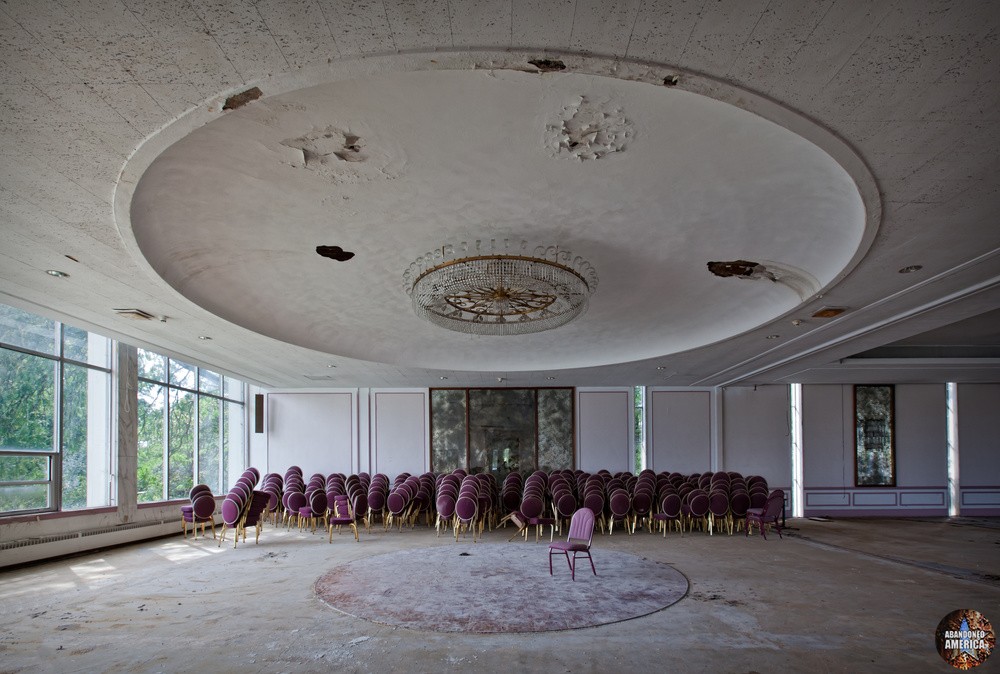
The ballroom at the abandoned Fallside Hotel
The reviews for the Fallside, still floating around the online ether after the hotel’s closure, are abysmal. One guest who stayed there in 2008 complained, “This hotel was a mess. First of all, the keys for the room did not work. Each and every time we left the room and came back we had to try the key about 10 or more times before it would work. The service was very very poor. Their so-called free breakfast when we went down for it the service people in a very rude manner said it's closed and we would have to pay. The room was totally a disaster. There was cobwebs, dirt on the window ceil, the ice bucket was dirty, the toilet didn't work - each time we use it we have to fiddle with it so that it flush. Each time we slept on the bed it felt like we were sleeping on someone's mess. I would never go back there.” Another reviewer in 2006 angrily wrote of booking the hotel for a large group. The keys and air conditioning didn’t work, the rugs were filthy, a pillow case had blood on it, and the toilet had no cover. When $2,500 worth of camera equipment was stolen from the room in what the police determined was an inside job, the General Manager brushed it off: “What do you want, my employees only get paid $8.00 an hour, and why would you travel with all of your cameras?” Other online reviews, now gone, mentioned bugs, water leaking from the ceilings in rooms, and mold problems.
Niagara Hospitalities filed for tax breaks to help finance renovations which never occurred and the tax breaks were subsequently revoked. Over $60,000 in arrears for county property taxes, the hotel was abruptly shut down in 2009. In an article in the Buffalo News, the president of the Niagara Tourism and Convention Corp. related his shock at finding the building vacant: “The staff was trying to reach out to them a couple weeks ago," he said. "They walked over there and found out that the doors were closed.”
When I arranged permission to photograph the Fallside through the hotel’s current owner, Faisal Merani, about three years later, the interior was a mess. A few areas, like the remnants of the Circle, with its enormous chandelier and mirrored piano, were in relatively good condition, and the newer tower section of the building looked as though it had just closed. The hotel’s bar, Misty’s, seemed like it could be reopened any time, but just around the corner black mold spread ominously up the walls. Most areas in the older section were in much worse condition: sheets of paint and wallpaper hung haphazardly from the walls, moss grew on carpets, and the laminate on the nightstands buckled into odd shapes amid stagnant pools of water. Though the vandalism would get much worse in the year or so to come, there was already evidence of it during my visit, including rooms where it was apparent squatters had been sleeping. Thieves scrapping copper wiring and plumbing also were problems; though I didn’t know it at the time, part of the reason for the water damage was because scrappers had left gaping holes in the roof. The water had been shut off improperly and the pipes broke during one of the winters, leaving water to gush into parts of the hotel for days. It was a building full of odd juxtapositions. Some rooms were as good as new, but in others crooked wall decorations glared menacingly over plaster-covered beds like malevolent eyes. The ballroom was still nearly immaculate, but the lobby was in shambles. Merani spoke of his own surreal experiences in the hotel, such as an encounter with a fox at the base of the stairs near the ballroom.
AOne of the less damaged rooms in the old Fallside Hotel
The Merani Hotel Group owns the recently updated Four Points by Sheraton, which is on the property the Treadway Inn relocated to in 1963, and another renovated Holiday Inn on Rainbow Boulevard. The Fallside was their next investment in the community. The banking climate stalled the renovations, and then the environmental issues within the building hindered the project further. “If they had just renovated the building, it would be much different,” Merani said. “We wouldn’t have to tear down as much.” As it stood, the water damage and mold remediation made the Fallside an expensive project.
In 2014 the process of demolishing most of the abandoned hotel began, and the new Doubletree by Hilton opened in 2016, with 194 guest rooms, an indoor pool and gym, a restaurant, and a patio facing the Niagara River. Merani doesn’t see it as a gamble, citing upward trends in bookings at his other hotels and the unique location of the property. In addition to his track record of successful projects and his careful research into the tourism trends in the New York side of Niagara Falls, the portion of the Robert Moses Parkway that cuts the property and much of the rest of the city off from the river was demolished and turned into a pedestrian-friendly road and biking trails. Mayor Paul Dyster praised the change, saying “getting this project done is going to be tremendous, not just in a practical sense for the City of Niagara Falls, but [also] psychologically.” It’s hoped that making the falls more accessible to the town will lead visitors to explore it more, which in turn will help local businesses grow and thrive.
The significance of the Fallside, in any of its previous incarnations as a Treadway or Parkway or Day Inn or a Ramada Inn, was never so much about its architecture. While there were areas of the building that were beautiful, like the ballroom or The Circle dining area, its meaning is better understood through the lens of its relationship with those who visited it. For decades the local community regarded it as one of the finest restaurants and hotels in the area, a place where they hosted their proms or came to enjoy a glass of wine by the river and conduct business. Guests from all across the country stayed there, some for their marriages or honeymoons, some just to visit the falls themselves and wonder in awe at their majesty - as people had done for centuries before them. The city still faces adjustments and struggles in the years ahead, but the decision to reopen the riverfront and the investment in the area’s future by companies like the Merani Hotel Group are a promising indicator that Niagara Falls, New York might be preparing for a comeback. Just as the Parkway Inn mirrored the success of the American side of Niagara Falls when it was still flush with money from urban renewal projects and tourism, as well as its subsequent decline in the years that followed, I hope that its rebirth will be a symbol of a new direction for the area in years to come. Merani seems sure of it, and I trust his judgment of the prevailing winds there better than my own. At any rate, you can always stay at the DoubleTree by Hilton Hotel Niagara Falls yourself and see. That’s a personal recommendation, not an ad I’m getting paid to make - Merani was very kind to me about letting me photograph the old Fallside and offering his time to talk about his plans. He seems to really appreciate the area and wants to see it come back to life for the community, and I’d like to see that happen too.
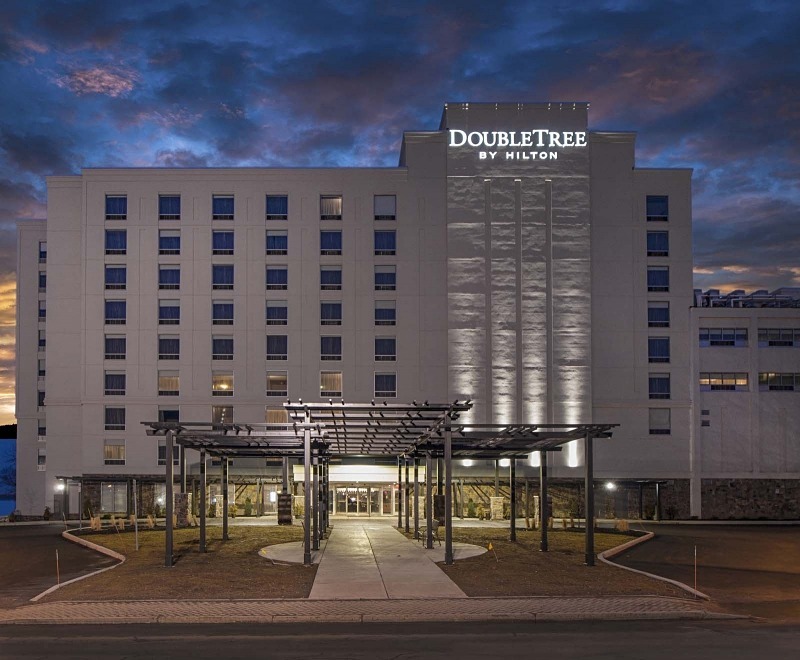
The new Doubletree by Hilton Hotels Niagara Falls Hotel (photo from their website) that replaced Fallside. Even if you compare it to the days when Fallside was open, it's quite an upgrade.
When I photographed the abandoned Fallside hotel in 2011, it seemed to be waiting. The transitions between sections that appeared to be part of a still functioning hotel and those that were in ruins were jarring; the remains of what it was were still very much present, yet the process of decay was already unraveling it. It was an uneasy relationship, and the building seemed to be hurtling towards its own precipice, an inevitable fate that would require it to be torn down to be built anew.
It was my birthday when I photographed the Fallside Hotel, a cold and gloomy morning that was about as unflattering to the surrounding area as possible. Despite the pall over the town, the hotel itself seemed transcendent. Water dripped, mold bloomed, and the slow but steady process of unrestrained erasure continued, indifferent to my presence. For such a small time, I was a part of the hotel so many others had passed through, for better or worse. Then the day finished, the moment was gone, and soon the Fallside Hotel was as well, off to whatever place all vanished things go when they are no longer a part of our waking world.
👉 Join Abandoned America on Patreon for high quality photos & exclusive content
👉 Make a one-time donation to help keep the project going
👉 Listen to the new Abandoned America podcast
👉 Subscribe to our mailing list for news and updates

